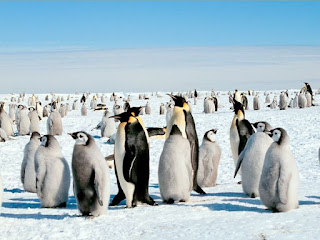Researching images and information about penguins from perhaps one of the most reliable sources (in the world?)- the National Geographic website. The National Geographic wildlife magazine is a global institution- for decades documenting socialogical, biological and geographic changes, events and occurances around the world.
On the website, along with many other wonderful features, there is the opportunity to view picture galleries from the featured National Geographic photographers- along with great information and insight about the specific images. The examples below have been sourced, with all the text also, from the website and writers themselves.
Adélie Penguin
Photograph by George F. Mobley
Wings spread, this Adélie penguin waddles through an Antarctic colony. Its black tail gives it a tuxedo-like appearance.
Adélie Penguin Rookery
Photograph by Peter Essick
Adélie
penguin parents take turns sitting on their nest to keep the eggs warm.
Constant care in their extremely cold habitat is crucial to chick
survival.
Chinstrap Penguin
Photograph by Ralph Lee Hopkins
Named for the thin black strip beneath its "chin," the chinstrap penguin is indigenous to Antarctica.Chinstrap Penguin on Rocky Coast
Photograph by Gordon Wiltsie
A chinstrap penguin gazes out from the rocky coast of King George Island in Antarctica.
Emperor Penguins
Photograph courtesy Giuseppe Zibordi/Michael Van Woert/
NOAA NESDIS, ORA
NOAA NESDIS, ORA
Emperor penguins are the largest penguins, standing about 4 feet (1.2 meters) tall.
Emperor Penguin Baby
Photograph courtesy NOAA
Wings spread wide, an Antarctic emperor penguin baby awaits its next meal.
Jackass Penguins
Photograph by Chris Johns
Contrary
to the popular image of penguins as ice-dwellers, jackass penguins live
in the temperate climate of southwestern Africa. Their name comes from
their loud, braying cry, similar to a donkey's.
King Penguins
Photograph by Maria Stenzel
King
penguins live on the more temperate islands north of Antarctica.
Although their habitat is warmer than that of emperor penguins, king
penguins have four layers of feathers and huddle together for warmth.
King Penguins
Photograph by Steve Raymer
King
penguins' flippers are distinctively large, helping them dive deep in
the icy ocean. On land, they waddle and toboggan across the ice—sliding
on their bellies, and propelling themselves with their flippers.
Rockhopper Penguins
Photograph by Steve Raymer
Rockhopper
penguins wear wispy, yellow-feathered crests on their heads. They make
their homes on the rocky shores of the islands off the southern tip of
South America.












No comments:
Post a Comment